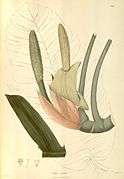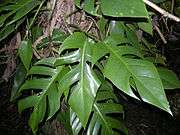Epipremnum pinnatum
Epipremnum pinnatum is a species of flowering plant in the family Araceae. It has many common names, including centipede tongavine and dragon-tail plant. In the Philippines, it is known in Tagalog as tibatib.
| Epipremnum pinnatum | |
|---|---|
_1.jpg) | |
| Large leaves pinnately-divided | |
| Scientific classification | |
| Kingdom: | Plantae |
| Clade: | Tracheophytes |
| Clade: | Angiosperms |
| Clade: | Monocots |
| Order: | Alismatales |
| Family: | Araceae |
| Genus: | Epipremnum |
| Species: | E. pinnatum |
| Binomial name | |
| Epipremnum pinnatum | |
| Synonyms[1] | |
|
Numerous
| |
Distribution
The plant has a broad native Old World distribution. Native range extends from Northern Australia through Malaysia and Indochina into southern China, Taiwan, Japan, and as far as Melanesia[2][3]. The species has also become naturalised in the West Indies.[3].
Gallery
 Illustration, Plantae Asiaticae Rariores, vol. 2: t. 192 (1831)
Illustration, Plantae Asiaticae Rariores, vol. 2: t. 192 (1831)_6.jpg)
 various forms of leaves in difference size
various forms of leaves in difference size_2.jpg) Aerial roots
Aerial roots
gollark: Since nowhere has ALL the stuff you need you need a ton of transportation.
gollark: But then you have to locate factories in places with the right minerals.
gollark: 2% or 0.5% efficiency or something, but they conveniently store to chemical energy
gollark: I was thinking just in general.
gollark: Presumably the idea is to use the other slaves to make food, but then you need even more slaves to manage.
References
- Epipremnum pinnatum (L.) Engl.. In: The Plant List (2013). Version 1.1. Published on the Internet; http://www.theplantlist.org/ [2015-2-28].
- Epipremnum pinnatum. In: Govaerts, R. (2015). World Checklist of Araceae. Facilitated by the Royal Botanic Gardens, Kew. Published on the Internet; http://apps.kew.org/wcsp/ Retrieved 2015-2-28.
- "Epipremnum pinnatum, Epipremnum pinnatum". Germplasm Resources Information Network (GRIN). Agricultural Research Service (ARS), United States Department of Agriculture (USDA). Retrieved 28 February 2015.
External links


This article is issued from Wikipedia. The text is licensed under Creative Commons - Attribution - Sharealike. Additional terms may apply for the media files.